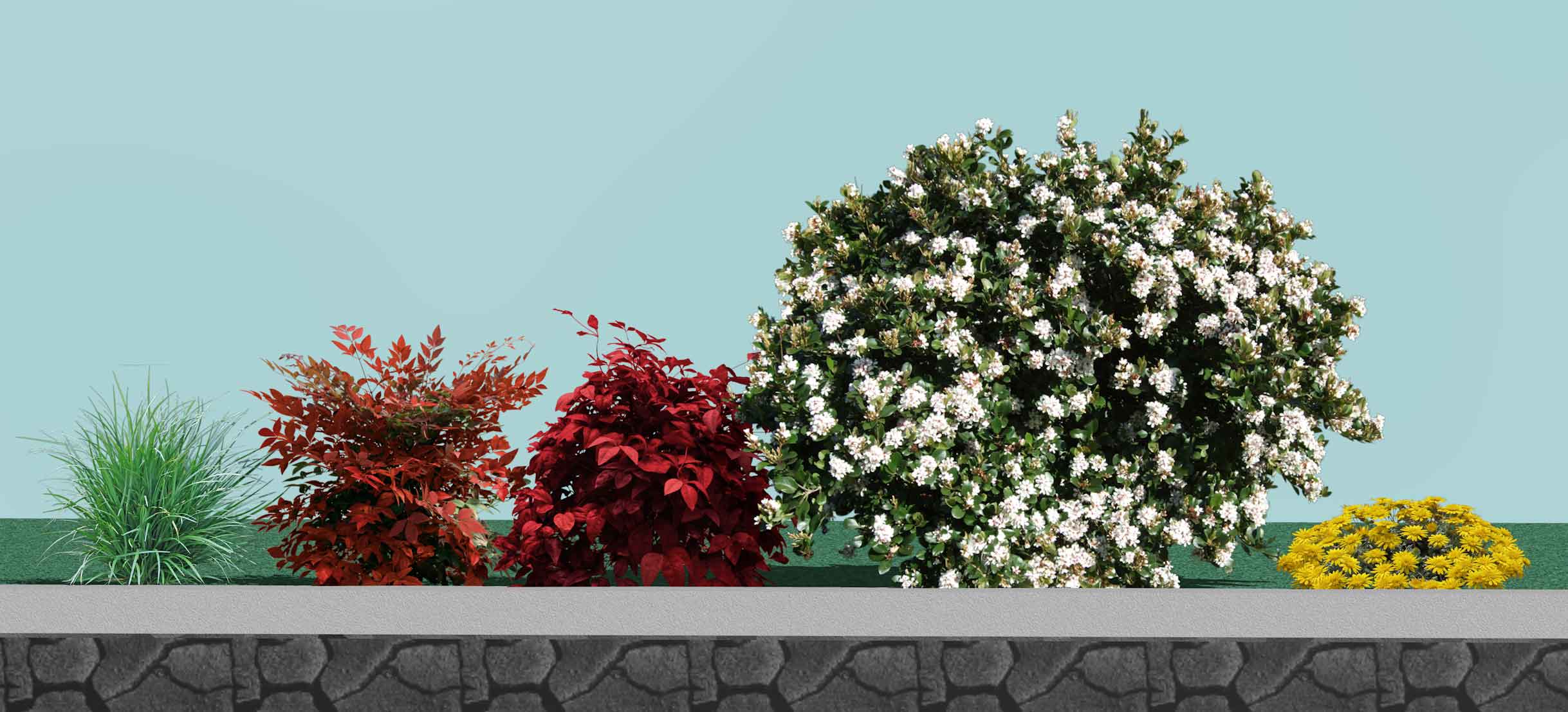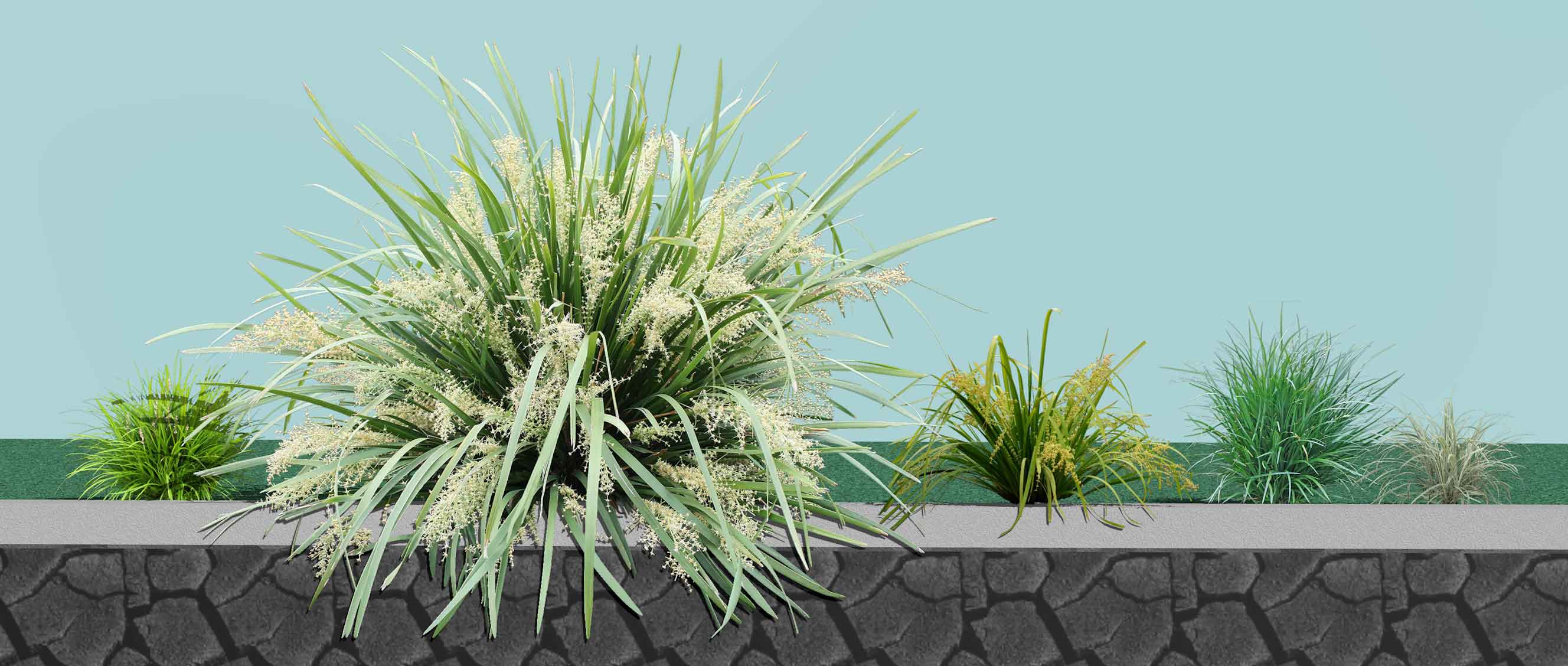Mixed Group Plantings: South Australian focus!
By Todd Layt
There has been a trend recently to use more plants in smaller group plantings rather than in large mass scale plantings. If the right plants are used this can work well, but if weaker plants are used, then the concept is only as good as the weakest plant. So when designing mixed group plantings what do you need to do to make the project work long term?
Firstly, design with a decade of performance in mind as a minimum. Make sure the right soil is being used for the plants chosen. If you want more diversity, use organics in the soil to promote better plant growth. Remember, someone will need to maintain the landscape, so choose plants and mulch that will reduce future maintenance inputs. Too much diversity impacts greatly on the cost of maintenance. Pruning or weed control becomes very costly with too much diversity – getting the balance right with enough range to be interesting, but not so much that the cost of maintenance sky rockets is a juggling act. The best ways to lower maintenance costs include: opting for large scale mass planting with plants that perform for at least a decade that need less pruning, using plants and mulch that help reduce weed pressures and equally as important is being very clever with plant selection for smaller group plantings.
The first and probably most important aspect is to get the soil preparation right; a good soil will help all plants perform far better, but it is not always that simple. Budget constraints often require the use of site soil. In this case, it comes down to plant selection, making sure you only use plants that can cope with the poor soils. Drainage is another important aspect for irrigated sites, which is common in South Australia. If the planting is on the lower side of a path, wet conditions from irrigation can make that side damp for longer periods, so it is necessary to use plants that can cope with wet feet on run off areas or depressed areas. If the site is rarely irrigated, or not at all, which is often the case, the plants also need to cope with severe drought.
Mulch selection is one of the most important decisions for the project. On a commercial landscape, the key role of mulch is to reduce weeds and its secondary role is to help add organics to the soil. Only chunky mulch with close to zero fines achieves the first goal. Mulch with small pieces or lots of fines actually acts as a potting mix and aids the germination of weed seeds. Avoid tub ground site mulch with fines, as this not only helps weed seeds germinate, it also is often full of disease and can kill most of the plants in a landscape. If you are forced to use this, make sure the plants can cope really well with Phytophthora and other diseases. Ozbreed has a number of plants that cope with this type of mulch, so if you must use it call Ozbreed and a list of those plants can be provided.
Plant selection is the other really important aspect. Smaller group plantings are only as good as the weakest plant and the maintenance level is often set by the plants that need the most upkeep, so choose plants that need less maintenance. There are enough good plants available for your region to choose long lasting, low maintenance options and still have good diversity in the project. Ten different plants installed in smaller groups of say 3 to 10 square metres per variety will provide a diverse landscape. South Australia has a varied climate, from hot and dry to very cold regions, so it is important to make sure the plants chosen work in the region. Below is a list of the best 10 plants for South Australia in general for low growing group plantings that will not only provide diversity, but also great companion planting, low maintenance, and a long lasting landscape.
Top 10 Native Plants for SA Group Plantings

^ Plants are described from 1-10 from left to right
1) Yareena™ Myoporum – This is the longer lived, tidier Myoporum. It has a woody base that keeps it alive a lot longer, while its mid-sized leaf keeps a tighter, tidier ground cover form, looking beautiful for many years.
2) Green John™ Callistemon – Tough as nails, Myrtle Rust resistant and smaller than ‘Little John’. Crisp, clean green foliage that contrasts nicely with its red flowers in spring and autumn. A lot more tidy and less woody compared to ‘Little John’. Can handle periodic wet feet better than ‘Little John’ and thrives in the dry. Loves the heat and harsh sun of SA.
3) Grey Box™ Westringia – A small, compact Westringia that is longer lived and handles drought well, yet copes very well with wet feet and cold. Loves the heat and harsh sun of SA.
4) Tanika® Lomandra – The most drought tolerant, tidy looking Lomandra. Millions have been used in South Australia with great results. With less brown through its foliage and a clean, crisp green, Tanika® Lomandra is one of a kind.
5) Little Jess™ Dianella – Needs better soils than the rest of the plants on this list, but provided the soil is good and organics are used, Little Jess™ Dianella spreads and fills in gaps, is low growing and looks great. Avoid for poor site soil situations, but if the soil is improved it will be one of the best plants in the project.
6) Tasred® Dianella – This has been a consistent performer in South Australia for over a decade. It does well in full sun and shade, as well as hot, dry and cold.
7) Cassa Blue® Dianella – This is the best performing blue foliage plant in South Australia. It lives really well in coastal wind-swept Adelaide as well as dry inland conditions. Avoid using in areas that regularly get wet feet from irrigation. For example, use on the top side of a path and use something else on the lower side of the path where the water runs off.
8) Mundi™ Westringia – This ground cover Westringia has performed well in SA in the dry as well as in periodic wet feet areas. A great non-fussy, low growing Westringia.
9) Macarthur™ Callistemon – Ideal if you want a plant that is a little taller, but not too tall. Copes well with the cold, hot and dry and is highly Myrtle Rust resistant, although that is not a problem in SA for now.
10) Nyalla® Lomandra – This is the go-to plant for coastal salt laden wind swept areas of South Australia. It has been one of the top performers along the coast of SA, but also does well inland.
Top 5 Exotics for SA Group Plantings

^ Plants are described from 1-5 from left to right
1) Just Right® Liriope – The only Liriope that does not burn in full sun in South Australia. It is smaller than ‘Evergreen Giant’ and much tougher. This has been a real star in SA and even stays evergreen in colder regions.
2) Obsession™ Nandina – With red foliage for 9 months of the year, this compact shrub is a great plant for mass planting or in rows if a more formal look is required. New growth is always red, where normal Nandina has green new growth.
3) Blush™ Nandina – More of a traditional Nandina look, but with red new growth in spring, summer and autumn.
4) Cosmic White™ Rhaphiolepis – Unbelievably tough. Dark green foliage and large white flowers twice per year. Best of all, it rarely if ever procures a berry, so it will not become weedy.
5) Double Gold™ Gazania – Gazania performs so well in South Australia, but normal Gazania will self-seed and often can become weedy. This Gazania is 100% sterile and cannot become weedy. Its bigger, more profuse flowers and nice blue grey foliage are a bonus. This is a really important plant now that seed producing Gazania have been banned. This one is exempt from the ban.
Best 5 Shade Plants for SA Group Plantings

^ Plants are described from 1-5 from left to right
1) Isabella® Liriope – This low growing, spreading Liriope is the ideal ground cover for shade gardens in SA. It can be mown once per year in August and is a great low maintenance, very shade tolerant lawn alternative.
2) Katie Belles™ Lomandra – This plant copes with heavy shade and even copes with wet heavy shade.
3) Tropic Cascade™ Lomandra – The weeping foliage looks great in a shade garden. It is more compact than other types of the species and has dark green foliage with beautiful sterile flowers in spring.
4) Just Right® Liriope – One of the best shade plants for SA, but does really well in the full sun also. Smaller than ‘Evergreen Giant’, but big enough for the mass planting effect.
5) Silverlawn™ Liriope – If you want a little colour contrast in a shade garden, Silverlawn™ Liriope will provide it in spades. Previously known as Silverstar™.
Remember, we are dealing with live plants and sometimes things go wrong in life, so have a follow up maintenance plan and at least one replanting phase if possible after one year to replace any dead plants. Landscape Architects and Designers often face a grim reality that the project did not quite turn out as planned after all the construction has been completed.
Some areas may be wetter than planned, the mulch not as good, the soil preparation was not as planned, or weed invasion was worse than envisaged. One or two of the plants may not have performed due to the changed circumstance or unforseen problems, so it may be necessary to replace underperforming plants with ones that worked on the project. If you are unsure of the conditions, choose plants that work in most conditions, but do not lose sight of specialised plants for specialised conditions. Slopes need very drought tolerant plants and wet feet is usually not an issue here, or gullies need plants that cope with wet feet, but also a little drought.
<< Back to Articles Home Page Landscaping Articles Full List of Articles
